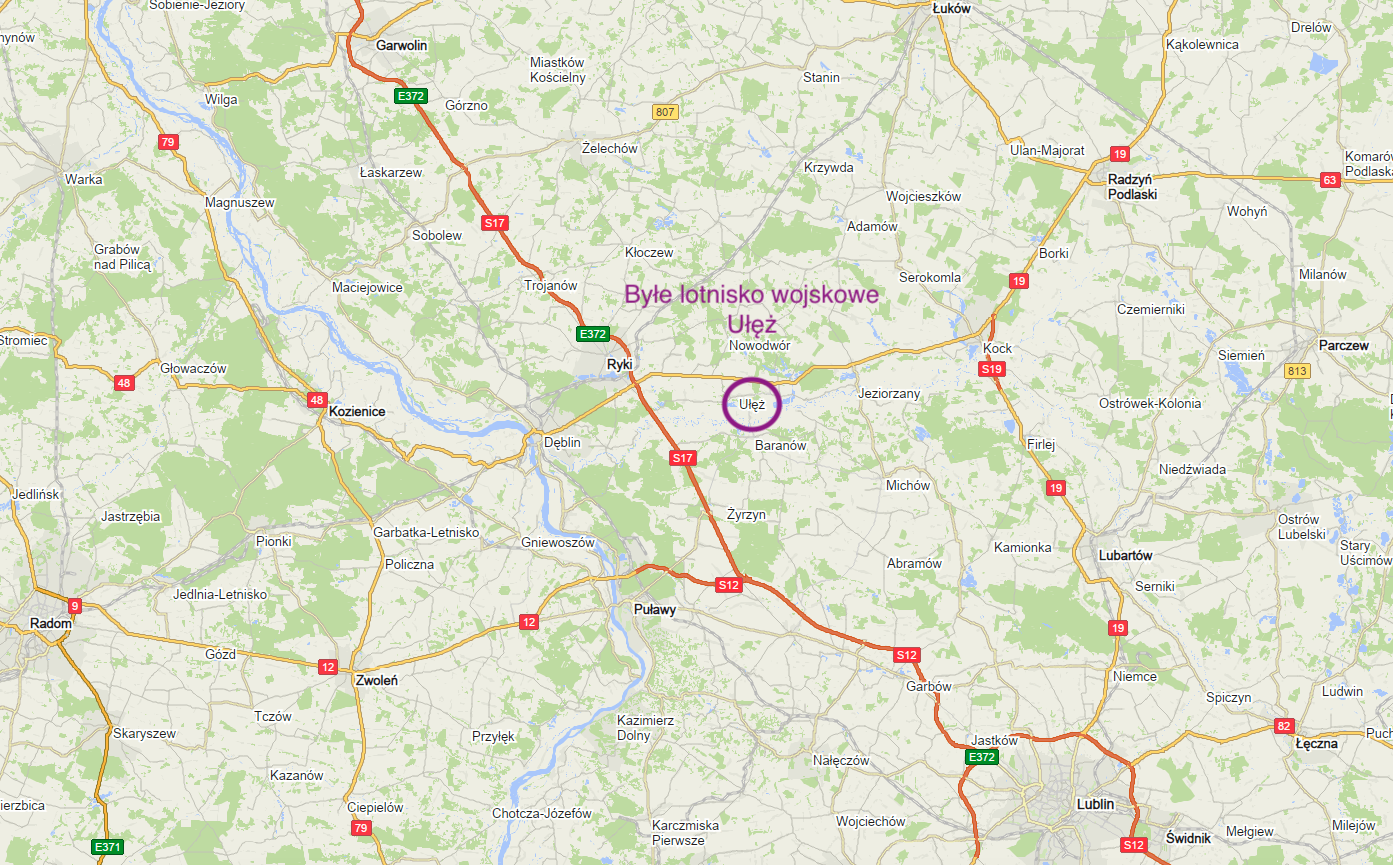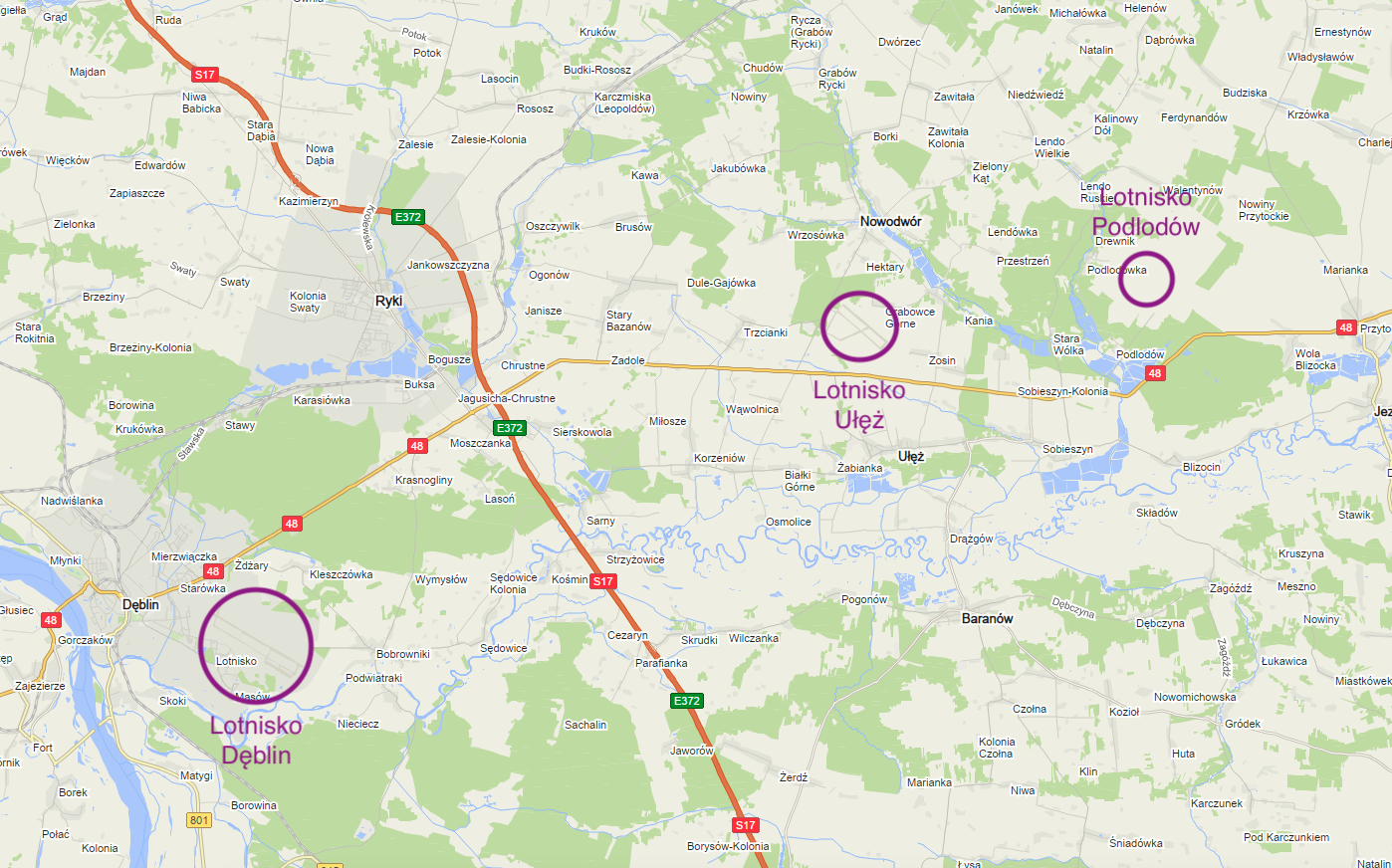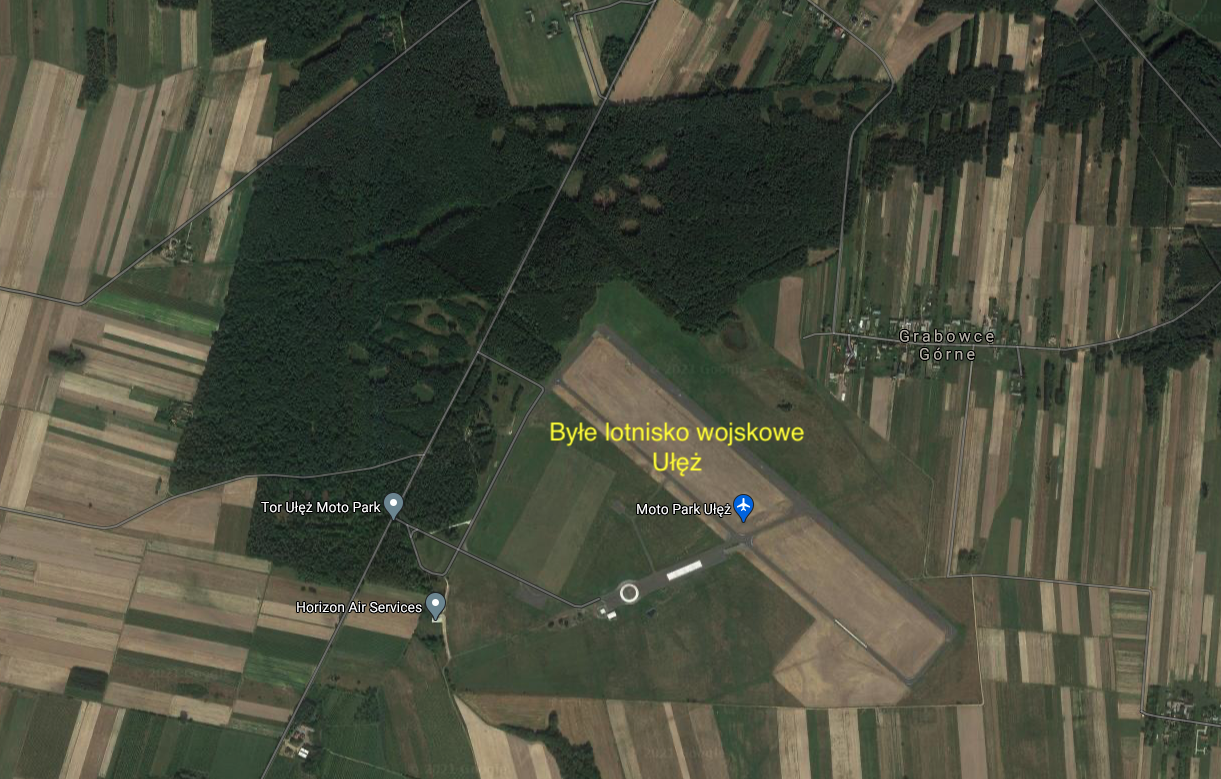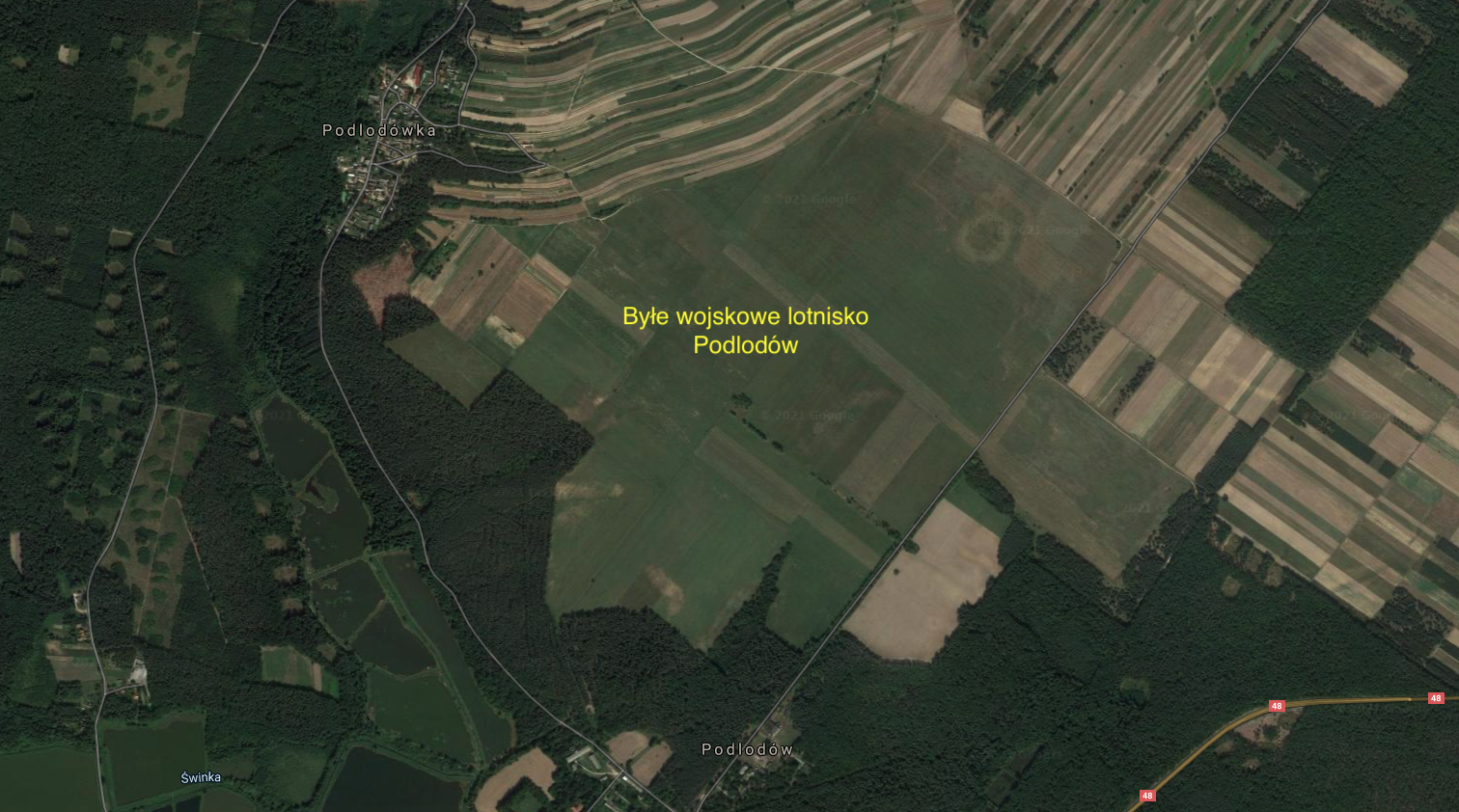Ułęż 2016-02-18
Ułęż and Podlodów airports.
Ułęż Airport. Geographic coordinates: 51.619N 22.101E. Elevation 172 m.
Ułęż.
Ułęż is a town located in the Lublin Voivodeship (since 1975), in Rycki County, in the Ułęż Commune. There are two former military airports in the commune. The first one is called Ułęż Airport, located north of Ułęż, next to the DK 48 road. The second airport, called Podlodów Airport, is located in the eastern part of the commune, only 10 km from the first airport. It is approximately 20 km from Ułęże to Dęblin. At the entrance to Ułęż from the side of national road No. 48, there is a plaque commemorating two fallen pilots: 2nd Lt. pil. Zbigniew Dobrzański and Cpl. pil. Lech Kaczmarek. They died during the Defensive War on September 9, 1939, hit by the on-board weapons of a German plane. In 1991, Ułęż Airport and Podlodów Airport were taken over by AMW (Military Property Agency) and did not have to retain their aviation character. Both airports were waiting for investors and are ready for development.
The area of the Ułęż Commune is 84 square kilometers. The commune has 3,637 inhabitants, living in 12 towns. In 2016, Ułęż had 1,677 inhabitants. The postal code for the town is 08-504. The beginning of the landline telephone numbers is +48 81. Geographically, the Ułęż commune is located on the Żelichowska Upland and the Wieprz Pradolina, in the so-called Little Mazovia.
National road No. 48 runs through the Ułęż commune; Tomaszów Mazowiecki – Dęblin – Kock and national road No. 17; Warsaw – Lublin – Hrebenne. All roads in the commune are in very good condition. The commune is valued as a tourist destination. Jan Długosz mentioned the town of Ułęż in his Chronicle as "Ulanze Primum", "Ulanze Secundum". The most valuable monument of the commune is the palace designed by Jan Kubicki from the 19th century, modeled on the Belvedere Palace in Warsaw. Currently, it houses the commune office. The commune’s attraction is the Sobieski Oak in Sobieszyn, dating back to 700 years ago. Other monuments include: the Church in Żabianka from 1745, the Church in Sobieszyn, the Palace in Sobieszyn and the manor complexes in Podlodów and Sarny. The commune’s inhabitants earn their living mainly from agriculture. There are 1,054 farms in the commune with a total area of 4,609 ha. 72% of the commune’s area is arable land. Forests constitute 23% of the area, and water reservoirs (including ponds – 150 ha) 7% of the area. Over 50% of households have access to the water supply network. In the commune there are: two primary schools, one junior high school and two secondary schools (a general secondary school and a complex of agricultural schools).
In 1955, almost the entire town of Ułęż was destroyed by fire. One of the reasons for such large starts was the tight development of the town. It was the third large fire in the history of the town.
The Germans left behind many souvenirs in the form of many crime scenes. They carried out the first mass execution in 1941, at the Ułęż Airport, murdering over 20 people from a Roma (Gypsy) camp, on suspicion of stealing fish from nearby ponds. A year later, they committed a similar crime, murdering over 20 more people; men, women and children.
The airports in this part of Poland belonged to the so-called pre-war Dębliński hub. These were airports near the towns of Borowa, Gołębie, Podlodowo, Ułęż and Zajezierze. The nearby airports were; Nosów near Biała Podlaska (P.23 Karaś), Marynin near Radzymin (P.23 Karaś), Łuszczów, Motycz, Strzelce near Hrubieszów, Jabłonna near Lublin. These airports were designated by the Polish Army (General Inspectorate of the Armed Forces and General Staff) at the beginning of the 30s of the 20th century. They served as field, reserve, ambush or emergency airfields. They were usually located near landed estates, because it guaranteed good social conditions for mechanics, pilots and officers. The surrounding orchards made it easy to camouflage planes. Meadows and pastures were sufficient runways. The forge was a field workshop, and the stable with horses guaranteed reliable transport.
Ułęż Airport.
Ułęż airport was a priority airport. The plans of the Polish Army were to serve as a backup airport for Dęblin with the possibility of educating cadets. Therefore, its infrastructure was extensive. The airport was put into operation in 1937. It was one of the modern training airports. It had two brick and steel hangars with glass, barracks, quarters for staff, a casino, warehouses, a fuel depot, guardhouses and others. Among them there were several brick buildings. They were all single-story. However, most of the buildings were wooden in the form of barracks. Most of the buildings were placed in the nearby forest and only clearings remain.
In the period from 1937 to 1939, the Ułęż Airport was used to train pilots from the school in Dęblin. In the spring of 1939, the Pilotage School was moved to Ułęż from Grudziądz, commanded by Captain Pilot Stanisław Brzezina. Upon mobilization, the 10th Bomb Squadron was based at the airport, renumbered as the 210th Bomb Squadron (211 and 212 Squadron). The unit had 18 PZL-37 Łoś bombers, one Fokker F-VII transport and several RWD-8 liaison planes.
After the attack of the German army on the Republic of Poland, the airport was used by the Luftwaffe aviation and as a place of extermination of the civilian population. During the years of occupation, the Germans gave some buildings their own names, such as Posen (Poznań) or Graudenz (Grudziądz), painting the coats of arms of these cities on them.
In the summer of 1944, when the eastern front was approaching, the Germans withdrew, blowing up almost all the facilities. They also destroyed the concrete runway, destroying it with bombs.
At the beginning of 1945, the Russians handed the airport over to the Polish side as the facility was very damaged and unfit for use. The Ułęż airport was taken over by the Dęblin Pilot School, and then by the Radom School (OSL-Radom). The airport was rebuilt to a usable condition, but it never reached the level of the Second Polish Republic. The main focus was on expanding the take-off area, rebuilding the concrete runway and building taxiways and PPS (Aircraft Standing Planes). The airport received the status of a field airport.
In 1958, the 24th Reserve Pilot Squadron was based at the airport. In the 1960s, during another renovation of the take-off field, the surface was covered with asphalt-concrete and this method of maintenance was maintained until the army left the area. The main runway (RWY) then had dimensions of 1,370 m x 30 m. This runway was freely used by Lim-1/2/5/6 aircraft. In the 1970s, the 24th Helicopter Training Squadron, using Mi-2 helicopters, was based at the airport. During this period, the squadron commander was a German pilot captain and pilots from Arab countries were also trained.
In 1991, Ułęż Airport was taken over by the Military Property Agency and was waiting for development. Currently (2017) there is a car and motorcycle track run by a school for improving driving techniques. Motor events take place here. Now Ułęż Airport has the status of a landing site and each time you need to obtain the consent of the manager. The airport has coordinates N51°37’08.8" E22°06’05.1". 560 ft. RWY elevation with an asphalt-concrete surface on the 131/311 direction, dimensions 1,400 m x 30 m. The airport was converted into a car racing track. There may be obstacles on the runway and taxiways defining the route of a motorcycle or car slalom.
Podlodów Airport.
The town is called Podlodów, but on some maps the name Podlodówka can be found. The first mention of the town of Podlodów dates back to 1569 and provides information about a farm and a village. The owner was Grzegorz Podlodowski. There is a manor house in the town of Podlodów, which is a good base for a field airport. The manor complex dates back to the first half of the 19th century. The first buildings in this place were built in the 17th century. The manor was expanded in the second half of the 19th century and at the beginning of the 20th century. At the same time, in the first half of the 19th century, a park was established. The systematic development of the estate ended in 1939. Later there was only relegation. In 1944, the communists deprived the property of the rightful owners. The Podlodów estate, amounting to 601,816 ha, was incorporated into the National Fisheries Farm with its seat in Lublin, branch in Kock with its seat in Podlodów. Years later, it was transformed into the State Fisheries Farm sp z o. o. Kock. In 1973, the manor complex was entered into the register of monuments, confirmed by subsequent entries in 1985 and 1996. One of the historic buildings is the so-called steward’s house, which was built around 1900. Currently it is a residential house and a shop.
The airport was established in the mid-1930s as an airport similar to an alternate (auxiliary) airport. The ascent field was not perfectly even, but sufficient and very large. The layout of the take-off field did not allow for good camouflage of planes, as it was surrounded by fields where potatoes were grown in 1939.
On August 31, 1939, the 215th Bomb Squadron (216 and 217 Squadron), previously designated XV, was stationed at the airport. Bomber Squadron, based from Okęcie Airport. The squadron was equipped with PZL P.37 Łoś planes (about 18 copies) as well as several RWD-8 planes and one Fokker F-VII transport plane. Both Squadrons took part in the Defense War of 1939. Due to the potato patches mentioned above, soldiers and civilians dug potatoes, the field was leveled, sod was laid and taxiways were made to position the planes under the trees and camouflage them.
During the occupation, the Germans built a concrete runway on the landing field. A dozen or so years ago, you could find fragments of concrete that was the surface of RWY. Presumably there were two runways arranged in a cross shape.From the fall of 1945, pilots for the Polish People’s Army were trained at the airports in Ułęż and Podlodów using UT-2 aircraft. Sometimes Po-2 planes were based at the airports.
In 1952, the 5th Basic Pilot Squadron was formed at OSL-4 in Dęblin. The commander was captain pilot Kazimierz Ciepiela. At the beginning of 1953, Officer Aviation School No. 5 underwent another reorganization, simultaneously moving to a new position No. 20/266. Therefore, the 5th Basic Pilot Squadron was transferred from OSL-4 in Dęblin to OSL-5 in Radom. At the same time, the Podlodów Airport was handed over to the school, which became the place where the Squadron was stationed. Pilot training was conducted based on Polish Junak-2 aircraft.
Due to the adoption of new aviation technology by the Polish Army, which required the expansion of the supply system and airport infrastructure, another reorganization was carried out in 1957. In February 1958, the school and squadrons in Podlodów were disbanded. The airport itself was put under the command of OSL-4 from Dęblin. The following commanders of the 5th Basic Pilotage Squadron were captain pilots: Kazimierz Ciepiela, Andrzej Adamczuk (1953-1954), Stanisław (1954-1957), Piekara (1957-1958). Many soldiers were conscript soldiers. The trained pilots were cadets who had, for example, parachute training. The professional staff consisted of officers and non-commissioned officers. Apart from the commander, the most important were the secretary of the POP (the basic party organization of the PZPR) and the instructor of the ZMP (the Polish youth union). Only further were: the head of communications, the PE instructor (physical education), the squadron chiefs, the clerk, the typist (civilian employee), the parachute instructor, the parachute stacker, the squadron navigator, the key commanders, the instructor pilots, the key technicians, the (senior) aircraft mechanics, the mechanics engine mechanics, on-board instrument mechanics, electrical installation mechanics, aircraft weapons mechanics, radio foreman, company commanders and heads, doctor, feldsher, economic non-commissioned officer, chief of MPS, equipment engineer or technician, weapons engineer or technician, cooks, guards.
Throughout the entire existence of the 5th Basic Pilot Squadron, Junak-2 training aircraft were used, replaced by TS-9 Junak-3. The main difference between these aircraft was the landing gear system. TS-9 Junak-3 had a front wheel, not a tail wheel.
Currently, there is no trace of the runway. In 1991, Podlodów Airport was taken over by AMW and is still waiting for development. The fly field serves as agricultural land leased by nearby farmers.
Coordinates 51 36 49 N 22 11 16 E. Elevation 165 m above sea level. Currently, the flight field is a large meadow.
Written by Karol Placha Hetman




